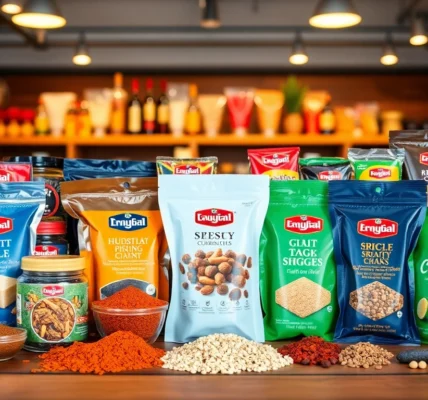Understanding the Role of a Food Manufacturer in Market Success
In the dynamic landscape of the food industry, a food manufacturer plays a pivotal role in shaping market trends, ensuring quality standards, and facilitating consumer trust. As a leading manufacturer and exporter of authentic food products, companies like Spice Nest exemplify how dedication to quality, innovation, and strategic branding can carve a competitive edge. The core functions of a food manufacturer extend beyond simple production; they encompass product development, stringent quality control, compliance with certifications, and proactive engagement with industry events.
Effective manufacturing begins with understanding consumer needs and market demands. This insight guides product design, sourcing, and processing techniques, ensuring that the final offerings—ranging from spices powder, whole spices, and cooking pastes to pickles and ready-to-eat foods—meet high standards of quality and safety. A successful manufacturer also invests in establishing robust supply chains, state-of-the-art processing facilities, and comprehensive traceability systems that uphold the integrity of their products across borders.
Key Advantages of Quality Manufacturing for Food Products
Prioritizing quality in manufacturing yields multiple competitive advantages:
- Consumer Trust: High-quality products solidify consumer loyalty and facilitate brand advocacy.
- Market Differentiation: Unique flavors, consistent textures, and superior packaging distinguish products in crowded markets.
- Compliance and Certification: Certifications like ISO, HACCP, Organic, and FSSAI propel international and domestic acceptance.
- Operational Efficiency: Streamlined processes reduce wastage, lower costs, and enhance throughput.
For example, Spice Nest’s certified manufacturing facilities enable them to export their signature spices, pastes, and dehydrated foods worldwide, reinforcing their reputation as a trustworthy and quality-centric manufacturer.
How to Differentiate Your Manufacturing Business in a Competitive Market
To stand out, manufacturers must focus on innovation, branding, and customer engagement:
- Innovation: Incorporate modern processing techniques—like dehydration or sterilization—to enhance shelf life and preserve nutrients.
- Brand Positioning: Emphasize authenticity, traditional recipes, and health benefits to connect emotionally with consumers.
- Certifications and Transparency: Obtain industry-recognized certifications and share detailed product information on packaging.
- Customized Offerings: Develop tailored products like Rajashthani-style chutneys or regional pickles to target niche markets.
For instance, Spice Nest’s diverse portfolio—including organic herbs, dehydrated foods, and ready-to-eat gravies—caters to a broad spectrum of customer preferences, further strengthening their competitive position.
Optimizing Production Processes for Food and Spices
Implementing Best Practices in Food Manufacturing
Best practices revolve around maintaining hygiene, automating processing where feasible, and implementing quality assurance protocols. Incorporating HACCP (Hazard Analysis and Critical Control Points) protocols ensures risks are mitigated at every step from raw material inspection to packaging. Additionally, employing GMP (Good Manufacturing Practices) guarantees the production environment is safe and contamination-free.
Technological adoption, such as modern grinding and packaging machinery, improves efficiency and product consistency. For example, Spice Nest’s advanced spice grinding units produce finely processed powders that retain aromatic compounds and flavor integrity.
Ensuring Compliance with Industry Certifications and Standards
Certifications serve not only as proof of safety but also as strategic marketing tools. Regular audits and stringent adherence to standards like ISO 22000, FSSAI, Organic, and Kosher certifications enhance credibility and open doors to international markets. Moreover, compliance with food safety standards facilitates easier customs clearance and reduces the risk of recalls.
At Spice Nest, continuous staff training, rigorous quality checks, and modernized infrastructure exemplify their commitment to maintaining certifications and industry standards.
Leveraging Innovation in Manufacturing Techniques
Innovation involves integrating new processing methods that improve product quality and shelf life. Techniques like dehydration preserve nutrients while reducing moisture content, preventing microbial growth. Similarly, sterilization and pasteurization in canned and sterilized foods ensure safety without compromising flavor or nutritional value.
Utilizing modern equipment and R&D, Spice Nest innovates with product formulations such as regional specialty chutneys and ready-to-eat gravies, capturing evolving consumer preferences.
Building a Strong Brand as a Leading Manufacturer
Creating Trust Through Quality and Certification
A robust reputation is built on consistent quality, transparency, and verified certifications. Displaying certifications and origin stories on packaging reassures consumers. For international buyers, formal documentation and traceability reports are crucial. Spice Nest’s presence at major exhibitions like Biofach 2024 demonstrates their commitment to quality and authenticity, enhancing brand trust globally.
Effective Packaging and Labeling Strategies
Packaging should protect products and communicate brand values. Eco-friendly, airtight packaging with clear labels specifying ingredients, certifications, nutritional info, and usage instructions optimize shelf appeal and compliance. Innovative designs, QR codes linking to detailed product stories, and tamper-evident seals foster consumer confidence.
Spice Nest’s diverse packaging options—from small jars to bulk containers—cater to retail and wholesale needs, broadening market reach.
Utilizing Export and Marketing Opportunities for Growth
Participation in international trade shows, digital marketing, and establishing local distribution channels are crucial growth strategies. Building relationships at major food expos like Biofach or Fi Europe helps expand global footprint. Leveraging certifications, quality credentials, and strategic branding amplifies market penetration.
For instance, Spice Nest’s successful showcase at Biofach 2024 solidified their reputation as a top Indian manufacturer and exporter of authentic spices and processed foods.
Engaging with Trade Shows and Industry Events
Maximizing Exposure at Food Exhibitions Worldwide
Trade shows provide unmatched platforms for product showcasing and networking. Preparation involves understanding attendee demographics, creating eye-catching displays, and providing samples. Digital presentations and social media promotions around these events enhance visibility.
Spice Nest’s strategic presence at events like Biofach and Gulfood has significantly increased their international visibility and orders.
Showcasing Your Products to International Buyers
Tailoring pitches to meet different cultural preferences and market requirements is essential. Providing product samples, certification documentation, and detailed catalogs facilitates trust-buidling. Using augmented reality and virtual tours during events can attract potential buyers globally.
Following Up for Long-term Business Relationships
Post-event engagement through targeted communications, sample follow-ups, and exclusive offers nurtures prospects into loyal clients. Continuous contact management using CRM systems ensures sustained growth and deeper partnerships.
Measuring Success and Scaling Operations
Tracking Performance Metrics for Food Manufacturing
Essential KPIs include production efficiency, defect rates, lead times, customer satisfaction, and export volumes. Regular analysis helps identify areas for improvement and guides strategic decisions.
Expanding Product Line and Market Reach
Market research, consumer feedback, and trend analysis support diversification into new segments such as organic herbs, superfoods, or regional delicacies. Scaling production capacity, expanding distribution channels, and enhancing online presence are vital growth pillars.
Spice Nest’s expansion into dehydrated foods and ready meals exemplifies successful diversification aligned with consumer demand for convenience and health.
Future Trends and Opportunities in Food Manufacturing
Emerging trends include organic certification, clean label formulations, functional foods with added health benefits, and sustainable packaging. Digital transformation via Industry 4.0 technologies (IoT, AI, automation) will optimize production and supply chain management.
Staying ahead involves investing in innovation, forging strategic partnerships, and participating in international trade initiatives, such as upcoming food expos in 2025-2026.

